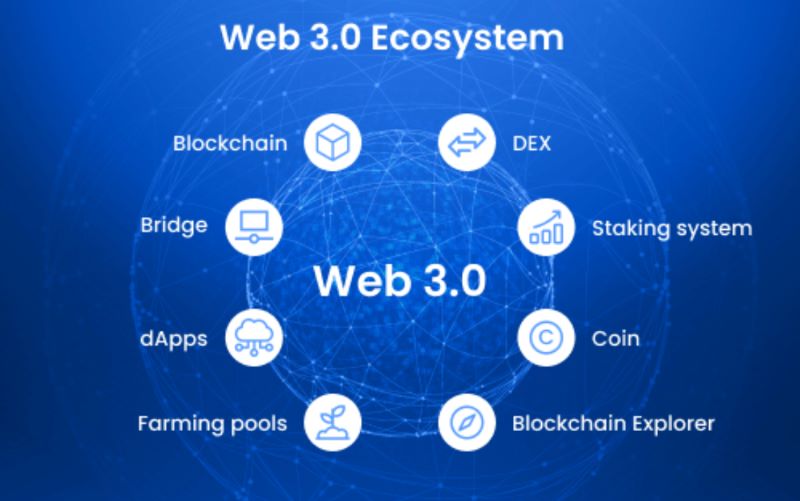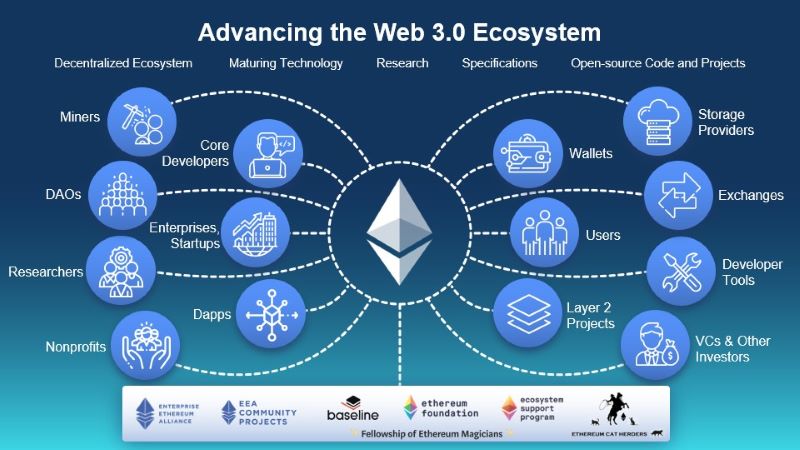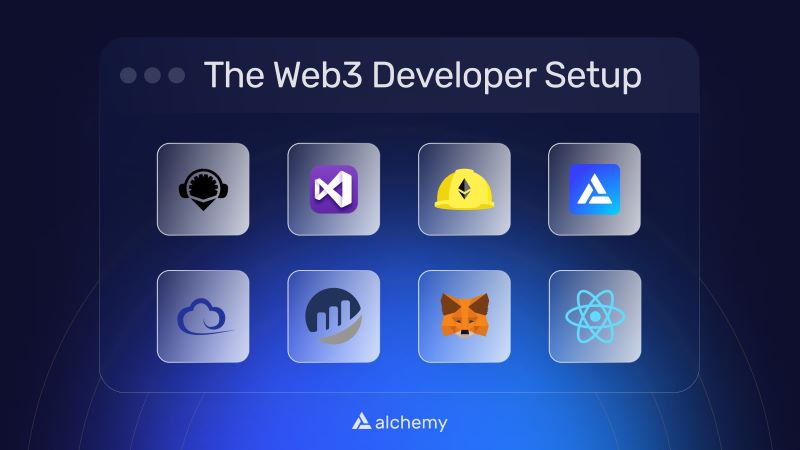Embark on an enriching journey through the Web3 Ecosystem: Guide to Tools & Platforms. Discover a wealth of resources and platforms that define the decentralized landscape. Whether you’re a novice or seasoned explorer, our comprehensive guide empowers you to navigate the intricate web of Web3 tools and platforms with ease. From decentralized applications to groundbreaking protocols, unlock the potential of the Web3 revolution and chart your course towards digital empowerment.
What is Web3 Ecosystem
Web3, also known as Web 3.0, represents the next generation of the internet. It is an upgraded version of the web, offering a host of new opportunities. Built on blockchain technology, Web3 is inherently decentralized, meaning no single entity has control, granting users greater power, control, and independence.
Web3 significantly enhances interactivity. We’re no longer just clicking and scrolling; with Web3, we’re creating, interacting, and even owning parts of the digital space. It’s akin to transitioning from watching TV to being part of the TV show. The tools and technologies to facilitate this shift are becoming increasingly accessible.

What truly sets Web3 apart is how it transforms online interactions. Here are some key aspects:
Decentralization: Web3 operates on blockchain technology, where data isn’t stored in a single location, eliminating the need for intermediaries and giving you control over your data.
Interactivity: Web3 is highly interactive. You’re not just a viewer but a participant, able to create, trade, and interact in ways previously impossible.
Smart Contracts: These are self-executing pieces of code that automatically carry out transactions when specific conditions are met. Whether trading digital art or purchasing virtual land, smart contracts facilitate these processes seamlessly.
Think of Web3 as a vast, open playground where you can explore, create, and engage without traditional rules and restrictions. And the most exciting part? You’re not just a visitor; you’re an integral part of it. This exploration of the Web3 ecosystem, tools, platforms, and technologies is what we’ll delve into next.
Future of Web3
The future of Web3 is like an uncharted sea, brimming with potential treasures and hidden challenges. As we venture further into exploring the Web3 ecosystem, tools, platforms, and technologies, several exciting trends are emerging.
Mass Adoption: With more people becoming comfortable with digital currencies and decentralized applications, the adoption of Web3 technologies is likely to increase. From purchasing a cup of coffee with Ether to earning a living in the metaverse, the ways we interact with the digital world are poised for radical change.
Interoperability: As different blockchains become more interconnected, transferring assets and information between them will become easier. This could lead to new possibilities, such as using your Ethereum-based NFTs in a game built on Solana.

Decentralized Finance (DeFi): DeFi is not just about exploring the Web3 ecosystem; it is about reinventing the financial system itself. From lending and borrowing without banks to earning interest on digital assets, DeFi has the potential to significantly disrupt traditional finance.
Governance: As Web3 platforms grow, users will demand more influence over how these platforms are run. This could give rise to new forms of online communities where users have a direct say in the rules and policies governing the platform.
Web3 Tools
Let’s dive into the toolset that powers Web3, enabling you to interact and engage with this cutting-edge ecosystem. These tools are like your digital toolbox, packed with everything you need to explore the Web3 world, from platforms and applications to underlying technologies.
Here are some of the key Web3 tools:
DApps: Short for decentralized applications, DApps run on a peer-to-peer (P2P) network of computers rather than a single server. They are open-source, meaning anyone can view, use, or modify the code, ensuring transparency and community-driven development.
Wallets: Unlike traditional wallets, digital wallets in Web3 store your cryptocurrency and digital assets. They also manage your digital identity on the Web3 network, allowing you to interact securely and seamlessly with various DApps and services.
Oracles: In the Web3 ecosystem, oracles serve as bridges between the blockchain and the real world. They provide smart contracts with external data, enabling more complex and useful applications, such as price feeds for decentralized finance (DeFi) protocols or real-world event tracking.
Protocols: These are the rules and standards that govern the network. Protocols ensure that all transactions and interactions are secure and efficient, providing a foundation for interoperability and trust in the decentralized web.
These tools are your keys to the Web3 world, empowering you to interact, transact, and explore the digital landscape. Whether you’re buying digital art, trading tokens, or simply exploring, these tools have got your back.

How to Use Web3 Tools
Understanding Web3 tools is one thing, but knowing how to use them is another. Let’s dive into how you can start exploring the Web3 ecosystem, tools, platforms, and technologies.
First, you’ll need a digital wallet to store your cryptocurrencies and digital assets. MetaMask is a popular choice, and it’s user-friendly. Simply install the extension in your browser, create an account, and you’re ready to go.
Next, you’ll need some Ether, the cryptocurrency used on the Ethereum platform. You can obtain Ether from a cryptocurrency exchange or by mining.
With your wallet set up and Ether in hand, you can start interacting with decentralized applications (DApps) on the Ethereum platform. This is where you can fully explore the Web3 ecosystem.
For instance, you might use a decentralized finance (DeFi) platform to lend or borrow funds, or a decentralized marketplace to buy and sell digital assets. Each interaction is a transaction, requiring a small fee paid in Ether.
While Web3 offers exciting opportunities, it also comes with risks. Always do your due diligence and only invest what you can afford to lose. With patience and curiosity, you’ll soon be navigating the Web3 world like a pro.
Web3 Platforms
Now that we’ve covered the essential tools of Web3, let’s explore the platforms. These platforms are the digital playgrounds where you can use your Web3 tools to interact, create, and explore. Here are some of the key Web3 platforms you should know about:
Ethereum: One of the most popular Web3 platforms, Ethereum functions as a global computer that allows developers to build and deploy decentralized applications (DApps). Its robust ecosystem and smart contract capabilities make it a cornerstone of the Web3 world.
Polkadot: Polkadot is a multi-chain platform that enables different blockchains to interoperate seamlessly. Think of it as a network of networks, each with its own unique features, connected through a central relay chain to ensure smooth communication and scalability.
Filecoin: Filecoin is a decentralized storage network that reimagines how we store data. Instead of relying on a single location, Filecoin distributes files across multiple nodes, ensuring data redundancy, security, and accessibility.
Decentralized Finance (DeFi) Platforms: These platforms leverage blockchain technology to provide financial services like lending, borrowing, and trading without traditional banks. Examples include Uniswap, Aave, and Compound, which offer innovative financial products and services directly to users.
Each of these platforms has unique features and functionalities, but they all adhere to the core principles of decentralization, transparency, and security.

With these platforms at your disposal, exploring the Web3 ecosystem becomes a digital adventure. You can create, transact, interact, and even earn — all while maintaining control over your data and identity. So dive in, and start experiencing the transformative potential of Web3 platforms today.
How to Use Web3 Platforms
Web3 platforms are essentially online spaces built on blockchain technology. They allow for peer-to-peer interactions without the need for a middleman. Imagine being able to trade digital assets directly with someone else, no bank or payment processor needed. That’s what Web3 platforms offer.
To get started, you’ll need to connect your digital wallet. This process is typically straightforward, involving a “connect wallet” button and a few prompts to follow. Once your wallet is connected, you can begin interacting with the platform.
Take OpenSea, a decentralized marketplace, as an example. On OpenSea, you can buy, sell, and trade digital assets like NFTs. With your wallet connected, you can browse listings, place bids, or list your own assets for sale. Every transaction is recorded on the blockchain, ensuring transparency and security.
Or consider decentralized finance (DeFi) platforms like Uniswap. Uniswap allows you to swap cryptocurrencies directly with other users and also provides opportunities to earn rewards by providing liquidity to the platform.
When exploring the Web3 ecosystem, it’s important to take your time. There’s a lot to learn and the landscape is constantly changing. However, with patience and curiosity, you’ll soon be navigating these platforms like a pro.
Stay ahead of the curve with the latest Forex trends News! Explore new opportunities and navigate market shifts with confidence. Whether you’re a seasoned trader or just starting out, our expert analysis and cutting-edge tools will empower you to make informed decisions. Don’t miss out on potential profits – seize the moment and take your trading to the next level today

